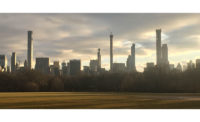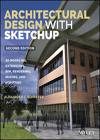Making (too) big plans for Manhattan's West Side
Green camouflage
In listening to one very well attended public presentation by the designers of the five schemes, I noticed another interesting form of misdirection. We are all greatly attuned to matters green nowadays, and each of the teams pressed that component to the fore, often with the landscape architect most prominently featured in making the case. (By the way, the Bloomberg administration has, under Doctoroff’s direction, produced what is, in many ways, a very impressive plan for the city’s sustainable growth, which is clearly having at least a rhetorical impact.) The evening was filled with talk of microclimates and runoff capture, of lawns and bosks, as if the schemes were somehow primarily about parks and not about the areola of 90-story monstrosities that would surround (and in most instances, cast into darkness) the open space. The environmental ethos—the very least we should expect from all of our building—was meant to lull and to camouflage. Ironically, for all the dulcet claims of up-to-date urbanism, we were served a massive dose of towers in the park. Of course, every scheme was depicted on a glorious summer-of-love day, all blue skies and blooms.
Although many sought to establish pedigree via comparisons to Rockefeller Center, the more apposite analogue is the Albany Mall. (Ah, those Rockefellers: We have them to thank for the original World Trade Center, as well. Not the best batting average.) The genius of Rockefeller Center comes from its architecture, its compactness, and its brilliant elision with its surrounding context. The Albany Mall is dreadful for its architecture, its Brasilia-like spatial extravagance, and its context-of-no-context megalomania. Four of the five schemes simply accepted the client-proposed Albany Mall parti of a rectangular green space with its long axis running east–west, lined by huge buildings with the jumbos generally at the east end, on axis or framing it. By and large, despite the claims of the authors, I was not persuaded that these parks—flanked by giant towers along their southern edges—were likely to be bathed in the photoshopped sunshine depicted in the renderings. Nor was I convinced that the orientation of the skyscraper-walled park toward the river would do much to prevent a massive generation of the Venturi effect on dark and windy winter days. And the literal link of the schemes to the riverfront showed truly massive failures of imagination: Virtually every project seized up on its cliff-faced podium beside the riverside highway, then extended a single tragic tendril across the road to the skinny shoreline park.
Best of a bad lot
Two projects had merit (ironically, the two that handicappers already think are most likely out of the running). Although I was ambivalent about the architecture as well as by the solar implication of the decision to put high towers to the south and a low bar building to the north, Holl’s scheme took strong cognizance of the mandate to overscale and did something about it. By putting his park on a suspension structure over the tracks instead of on a massive platform, and by building his towers on the flanking terra firma, his plan simply costs less and allows the developer to use the savings to reduce the overall scale of the thing. This is civic thinking. While I was uncertain of how Holl would solve the meeting of his suspension structure with the avenues (likely to produce a walled condition) and how much of the strength of the scheme would be lost if the individual buildings were franchised to other architects, this was still a very serious piece of design. But these cavils are probably moot. Without the indispensable anchor tenant brought by several other developers, this proposal is likely to sink.
The other seriously worked out project was that of Brookfield Properties, with an architectural team dominated by SOM but ornamented by a cadre of hipper practices. This was the one scheme that seemed to come to grips with the thornier issues of planning the site in its real particularity, and did so with intelligence. The biggest difficulty presented in building over the yards lies not so much in the need to span them, but in the very substantial change in grade from east to west, raising a classic problem of too-simple placement of buildings at the artificial grade of a podium. The Brookfield design (presented that evening by its landscape architect, James Corner) has a succinct and elegant modulation from street to podium, creating on its southern edge strong spaces at both lower and upper levels, and smartly integrating the High Line (the disused railway viaduct that runs from the site through the neighborhood to the south and is now being converted to a park). This was also the only scheme to subdivide the central park, creating two distinct spaces of differing character—an approach that strikes me as far more rational, both environmentally and programmatically. Much too much architecture, though.
Whether any of this wisdom will wind up in the project selected remains to be seen. Although the whole operation has been the object of uniformly scathing criticism by architectural critics, most of that is itself hemmed by the developers’ intended misdirection. Little is written about the larger planning, morphological, and artistic implications of building a clutch of Empire State Building–scaled towers at this edge of the island. Little is mentioned about the distributive ecologies of use, And despite the pieties about sustainability (the acceptable face of social responsibility), few voices can be heard questioning the real social content and effects of a project motivated primarily by the further enrichment of the city’s most privileged classes. Rupert Murdoch or S.I. Newhouse or Goldman Sachs will wind up with shiny new headquarters. Others will be obliged to look elsewhere. What a waste of a precious public resource.




